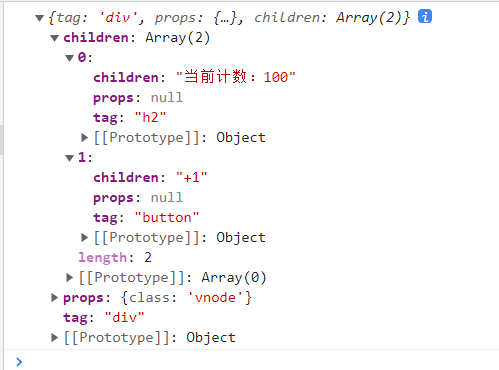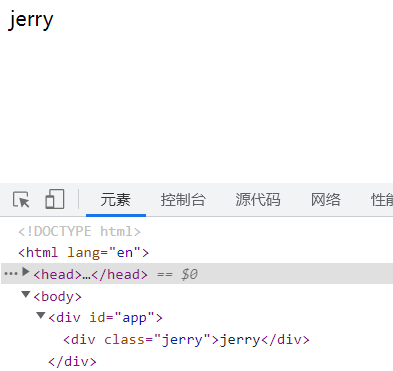vue3中VNode渲染节点的实现
vue的源码包含三大核心:
Compiler模块:编译模板系统
Runtime模块:也可以称之为Renderer模块,真正的渲染的模块
Reactivity模块:响应式系统
三个系统之间如何协同工作呢?

实现一个Mini-Vue
包含三个模块:
渲染系统模块
可响应式系统模块
应用程序入口模块
渲染系统的实现
该模块主要包含三个功能:
功能一:h函数,用于返回一个VNode对象;
功能二:mount函数,用于将VNode挂载到DOM
功能三:patch函数,用于对两个VNode进行对比,决定如何处理新的VNode
第一步,创建一个renderer.js文件,定义一个h函数
const h = (tag, props, children) => { // vnode就是一个JavaScript对象 return { tag, props, children } }
在html文件中,引入文件,并创建一个虚拟节点,可以输出打印一下这个vnode
<div id="app"></div> <script src="./renderer.js"></script> <script> // 1、 通过h函数来创建一个vnode const vnode = h('div', { class: 'vnode' }, [ h('h2', null, '当前计数:100'), h('button', null, "+1") ]) console.log(vnode) </script>

第二步,实现挂载功能
在renderer.js文件中定义mount方法
const mount = (vnode, container) => { //1、 将vnode变为elemnt,创建出真实的dom,并且在vnode上保存一份el const el = vnode.el = document.createElement(vnode.tag) // 2、处理props if (vnode.props) { for (const key in vnode.props) { const value = vnode.props[key] // 判断传递过来的是否是方法,比如onClick if (key.startsWith("on")) { el.addEventListener(key.slice(2).toLowerCase(), value) } // 设置属性 el.setAttribute(key, value) } } // 3、处理children if (vnode.children) { // 如果子节点存在并且子节点是字符串,说明是其中的内容 if (typeof vnode.children === 'string') { // 将内容放进去 el.textContent = vnode.children } else { // 说明子节点中是一个数组,其内部还有子节点 vnode.children.forEach((item) => { // 再次调用挂载到el上 mount(item,el) }) } } // 4、将el挂载到container上 container.appendChild(el) }
在html文件中调用该mount方法
// 2、通过mount函数,将vnode挂载到#app上 mount(vnode,document.getElementById('app'))
再次刷新页面的时候就可以看到界面已经加载出来了vnode

第三步实现diff算法
第一种情况:节点不相同
新建一个vnode
// 3、创建一个新的vnode const vnode1 = h('h2', { class: 'vnode' }, 'jerry')
将新的vnode替换旧的vnode,两个vnode之间进行一个diff算法,根据diff算法找到需要修改真实dom的那个地方,找到之后在进行修改
在renderer.js文件中定义一个patch方法
const patch=(n1,n2)=>{ // 判断两个vnode的类型是否一样,比如说n1为div,n2为h2 if(n1.tag!==n2.tag){ // 拿到n1节点的父元素 const n1ElementParent=n1.el.parentElement; // 移除n1节点 n1ElementParent.removeChild(n1.el) // 将n2节点添加上去 mount(n2,n1ElementParent) }else{ } }
在html文件中使用patch方法
patch(vnode,vnode1)
再次刷新页面可以看到已经替换

第二种情况:节点相同,类名不同
patch方法
const patch = (n1, n2) => { // 判断两个vnode的类型是否一样,比如说n1为div,n2为h2 if (n1.tag !== n2.tag) { // 拿到n1节点的父元素 const n1ElementParent = n1.el.parentElement; // 移除n1节点 n1ElementParent.removeChild(n1.el) // 将n2节点添加上去 mount(n2, n1ElementParent) } else { // 1、拿出element对象,并在n2中保留一份 const el = n2.el = n1.el // 2、处理props const oldProps = n1.props || {} const newProps = n2.props || {} // 2、1获取所有的newProps添加到el中 for (const key in newProps) { const oldValue = oldProps[key] const newValue = newProps[key] if (newValue !== oldValue) { // 判断传递过来的是否是方法,比如onClick if (key.startsWith("on")) { el.addEventListener(key.slice(2).toLowerCase(), newValue) } else { el.setAttribute(key, newValue) } } } // 2、2删除旧的props for(const key in oldProps){ if(!(key in newProps)){ if (key.startsWith("on")) { const value=oldProps[key] el.removeEventListener(key.slice(2).toLowerCase(), value) } else { el.removeAttribute(key) } } } // 3、处理children } }
在html中新建一个节点,调用patch方法
// 3、创建一个新的vnode const vnode1 = h('div', { class: 'jerry' }, 'jerry') patch(vnode,vnode1)
之前

更新之后

接下来处理子节点
// 3、处理children const oldChildren = n1.children || []; const newChildren = n2.children || []; // 情况一:newChildren是一个string类型 if (typeof newChildren === "string") { if (typeof oldChildren === "string") { if (newChildren !== oldChildren) { el.textContent = newChildren } } else { el.innerHTML = newChildren; } }else{ // 情况二:newChildren是一个数组 if(typeof oldChildren==='string'){ el.innerHTML="" newChildren.forEach(item=>{ mount(item,el) }) }else{ // oldChildren:[n1,n2,n3] // newChildren:[n1,n2,n3,n4,n5] // 前面有相同节点的元素进行patch操作 const commonLength=Math.min(oldChildren.length,newChildren.length) for(let i=0;i<commonLength;i++){ patch(oldChildren[i],newChildren[i]) } // 如果newChildren.length>oldChildren // oldChildren:[n1,n2,n3] // newChildren:[n1,n2,n3,n4,n5] if(newChildren.length>oldChildren.length){ newChildren.slice(oldChildren.length).forEach(item=>{ mount(item,el) }) } // 如果newChildren.length<oldChildren // oldChildren:[n1,n2,n3,n4,n5] // newChildren:[n1,n2,n3] if(newChildren.length<oldChildren.length){ oldChildren.slice(newChildren.length).forEach(item=>{ el.removeChild(item.el) }) } } } }
创建两个不同的节点,在进行patch操作
// 1、 通过h函数来创建一个vnode const vnode = h('div', { class: 'vnode' }, [ h('h2', null, '当前计数:100'), h('button',{onClick:function(){}}, "+1") ]) // 2、通过mount函数,将vnode挂载到#app上 mount(vnode,document.getElementById('app')) // 3、创建一个新的vnode const vnode1 = h('div', { class: 'jerry' }, 'jerry') patch(vnode,vnode1)
此时页面就成为:




